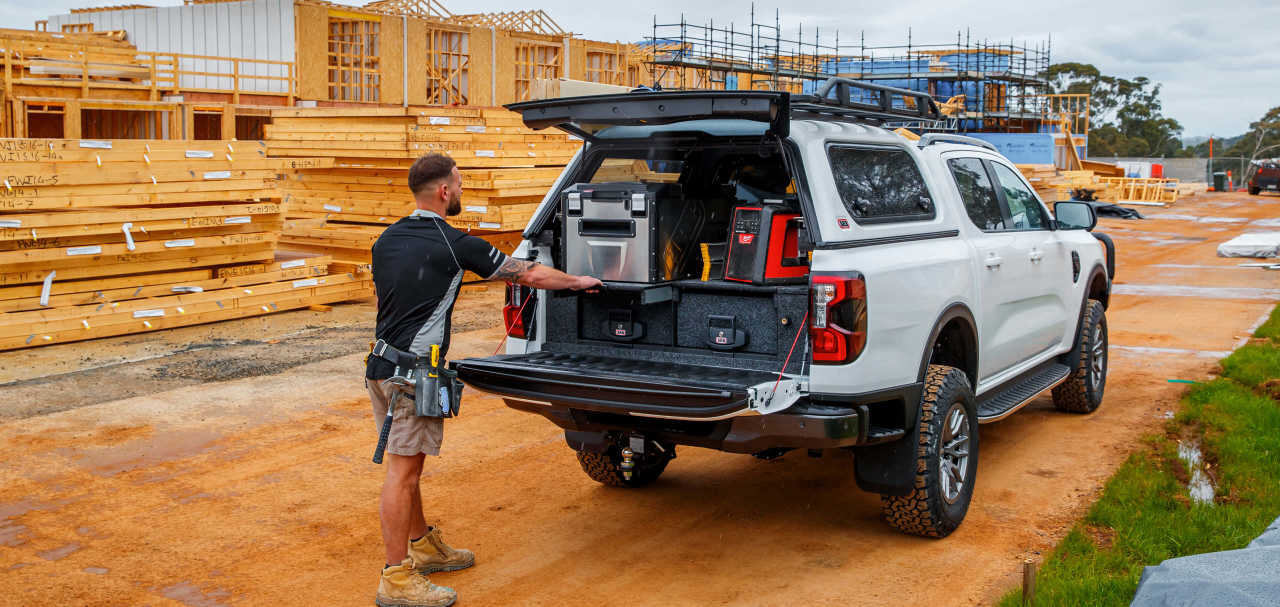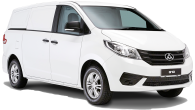Toyota’s current sixth-generation HiAce is an impressive all-rounder, offering a choice of wheelbases, body styles and engine/transmission combinations. These include four-cylinder turbo-diesel and V6 petrol engines with either six-speed manual or six-speed automatic transmissions.
We've previously tested the turbo-diesel automatic version, which is a consummate load hauler in the mid-sized (2.5-3.5 tonne) van market. So this time we were keen to sample a petrol manual variant, mindful that in 2017 Toyota dropped a V6 petrol engine option from its HiLux ute range due to near-zero sales volumes. After a week behind the wheel of this HiAce version, we think it may face a similar fate.
Toyota HiAce 2020: LWB Crew
| Engine Type | Diesel Turbo 4, 2.8L |
|---|---|
| Fuel Type | Diesel |
| Fuel Efficiency | 8.2L/100km (combined) |
| Seating | 5 |
| Price From | $29,260 - $35,310 |
| Safety Rating |
|
Does it represent good value for the price? What features does it come with?
Our test vehicle is the long wheelbase or LWB Van, with 3.5 litre V6 petrol engine and six-speed manual transmission, for a list price of $38,640. This compares favourably with the 2.8 litre turbo-diesel manual version at $42,140, which represents a substantial $3500 saving up front.
There’s only one specification available which includes any colour you like as long as it’s French Vanilla, 16-inch steel wheels with 215/70 R16C tyres, plastic wheel covers and a full-size spare, dual side-sliding doors with a window in the kerb-side door (a non-glazed version is optional) and a single-lift tailgate.
.JPG)
There’s also halogen headlights with DRLs, fabric-trimmed driver and passenger seats, leather-accented steering wheel with height and reach adjustment, cruise control and a 4.2-inch MID. There’s also a well-equipped infotainment system with steering wheel controls, 7.0-inch colour touchscreen and multiple connectivity including Apple CarPlay/Android Auto plus CD, USB, AUX and Bluetooth inputs.
Is there anything interesting about its design?
It has a large and imposing appearance, particularly with that polarising front-end design, but the HiAce soon starts to shrink around the driver as a result of its surprisingly agile handling characteristics. The front and rear bumpers feature plenty of hard-wearing black plastic surfaces designed to cope with the usual bumps and scrapes experienced by hard-working vans.
With its 5265mm overall length, 1950mm width and 1990mm height, the HiAce will easily fit beneath the low ceilings of multi-level car parks and its impressively tight 11.0-metre turning circle ensures that many expected two-point turns are single-turn manoeuvres.
.JPG)
The latest generation adheres to the HiAce’s traditional rear-wheel drive lay-out and rides on a 3210mm wheelbase, with tried and tested MacPherson Strut front suspension, leaf-spring live axle rear suspension, hydraulic power-assisted rack and pinion steering and front disc/rear drum brakes. In other words, nothing to see here.
What are the key stats for the engine and transmission?
Toyota’s 7GR-FKS petrol engine is an all-aluminium 3.5 litre DOHC multi-valve V6 armed with the latest VVTi (variable valve timing) technology claimed to enhance performance and economy. Its peak 351Nm of torque is tapped at a relatively high 4600rpm and maximum power of 207kW is found even further up the rev range at 6000rpm. The manual transmission has six speeds shifted by a short gear-stick mounted in a dashboard console.
.JPG)
How much fuel does it consume?
Toyota’s official combined figure of 12.4L/100km looks mighty thirsty compared to the relatively frugal 7.5L/100km claimed for the turbo-diesel version. Based on those figures, the petrol engine uses a whopping 65 per cent more fuel.
After 378km of testing, including a sizable portion at close to GVM, we managed to almost match the V6 petrol’s official figure with our 12.2, crunched from 'real world' fuel bowser and trip meter readings. So, if you filled its 70-litre petrol tank, you could expect a driving range of around 570km.
How practical is the space inside?
The 2135kg kerb weight and 3200kg GVM result in a genuine one-tonne-plus payload rating of 1065kg. It’s also rated to tow up to 1400kg of braked trailer and thanks to its 4600kg GCM (or how much it can legally carry and tow at the same time), it can tow that weight without any reduction in payload required.
The cargo hold, with its excellent 6.2 metres of load volume, is accessed via the two side sliding doors and the single-lift tailgate. However, there’s no option available for twin-swing rear barn doors like some rivals, so keep that in mind if rear forklift access is important. The roof is lined from the windscreen to the tailgate to help reduce noise levels in the cargo hold, along with wall and door linings.
.JPG)
The 2530mm-long load floor with 1268mm between the rear wheel housings allows the HiAce to (theoretically at least) carry two 1165mm-square Aussie pallets, or three 1200 x 800mm Euro pallets, secured by six floor-mounted anchorage points.
However, loading them would be a challenge given that there’s no forklift access from the rear due to the tailgate and the side door openings are only 1010mm. Fact is, the HiAce is not well suited to forklift loading.
There’s big 1.5-litre bottle holders and storage bins in each front door, plus smaller 0.5 litre bottle/cup holders on either side of the dash with another near the centre. There’s also a near-vertical single glovebox that can hold A4 files.
However, our crew of two ran out of places to store bulky items like their lunch boxes, as the HiAce lacks the superior use of space displayed by some rival vans which include, among other things, large storage areas beneath the seats. We ended up having to carry the lunch boxes on the floor behind the passenger’s feet, as they slid forwards or backwards under acceleration or braking if placed on the open floor space between the seats.
.JPG)
A great solution would be the extra-wide centre console fitted to the current Crew Van model, which looks more like a giant desk organiser and is ideal for storing personal items large and small including lunch boxes and even camera bags. Perhaps Toyota could offer the Crew Van console as an option, or at least as an accessory available for other variants?
What’s it like as a daily driver?
The difference between driving this HiAce and its predecessors is black and white. The driving position is more like an SUV than a van, as you sit behind the steering wheel and dash rather than over them like its uncomfortable ancestors.
The hydraulic power-assisted steering and leather-appointed wheel are nice to use and with sufficient adjustability in seat height/backrest angle, steering column height/reach plus a decent-sized left footrest, drivers of most shapes and sizes can find a comfortable position.
All-round vision and driver awareness is good with the front and rear parking sensors, reversing camera and particularly the window in the left-side sliding door, which removes a major over-the-shoulder blind-spot for the driver that can be hazardous when reversing onto a busy road.
.JPG)
For such a large vehicle it’s surprisingly agile in city and suburban driving, with safe and predictable handling, strong braking and its impressively tight turning circle. The clutch pedal and gearshift are lightly weighted and the V6 petrol engine’s performance is adequate when the vehicle is either empty or lightly loaded.
However, its characteristics don’t feel well suited to this working role, where low-down torque is king. The 3.5 litre V6’s 351Nm of peak torque is 100Nm less than its 2.8 litre turbo-diesel alternative and is tapped at 4600rpm, which is more than 2000rpm higher than the oil burner.
Fortunately, most of those 351Nm remain reasonably linear between 2000-4000rpm, so in terms of torque output it’s not as peaky as its figures may suggest. However, to extract maximum power when that torque is insufficient, you have to spin it all the way to a screaming 6000rpm. The end result is an engine that would seem more at home in a car than a heavy commercial van.
What’s it like for tradie use?
We forklifted 650kg of weight blocks into the cargo hold through the side doors and another 180kg through the tailgate. Combined with our crew of two, this equalled a one-tonne-plus 1010kg payload which just snuck in under the 1065kg limit.
Suspension compression front and rear was minimal, with heaps of bump-stop clearance remaining. With the load in the cargo hold being carried forward of the rear axle, it also felt nicely balanced and if anything more firmly planted on the road, with a negligible increase in steering effort.
.JPG)
However, the torque shortfall was noticeable in stop-start city and suburban driving with this payload, even more so at highway speeds. Torque fell away noticeably below 2000rpm, so highway driving generally required the use of lower gears and higher revs than a turbo-diesel to maintain cruising speeds, particularly in strong headwinds or if we needed maximum power to climb a hill or overtake another vehicle.
Overall, it just felt like it had to work much harder to achieve the same result, not to mention the much higher fuel consumption which gave our wallets a workout at the same time.
.JPG)
Warranty & Safety Rating
What safety equipment is fitted? What safety rating?
Maximum five-star ANCAP rating headlines the HiAce’s benchmark safety in the light commercial van market, including AEB with day/night pedestrian and day cyclist detection, lane departure alert with steering assist, blind-spot monitoring, rear cross-traffic alert and road sign assist to name a few. The peerless vehicle stability control menu includes trailer sway control and hill-start assist, plus there’s a reversing camera with guide lines and front/rear parking sensors.
What does it cost to own? What warranty is offered?
Like the rest of Toyota's range, the HiAce comes with a five years/unlimited km warranty. Initial scheduled service at 12 months/20,000km then every six months/10,000km whichever occurs first. Capped-price servicing of $180 (compared to $240 for diesel) for the first four scheduled services over 30 months/50,000km, whichever occurs first.
Verdict
The HiAce V6 petrol manual has cheaper capped-price servicing and undercuts its turbo-diesel equivalent by a substantial $3500 in purchase price. However, if they both cover say 15,000km per year, the petrol engine is going to use 735 more litres of fuel. Based on a notional petrol/diesel price of $1.50 per litre, that means an extra $1100 in annual fuel costs.
So, after three years, most of the $3500 saving on purchase price will have literally been burned up by its 65 per cent higher fuel consumption alone. The petrol HiAce also has 100Nm less torque and inferior engine braking, which begs the question HiLux buyers must have pondered before the demise of the V6 petrol HiLux: why would you buy one?
Pricing Guides




.JPG)
.jpg)

.jpg)


.jpg)

.jpg)
.jpg)


.jpg)
.jpg)


.jpg)
.jpg)
Comments